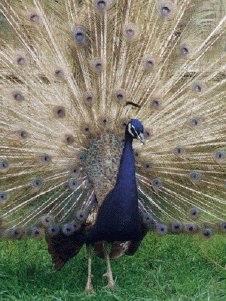Purple
 |
The newness of this variety, coupled with its sex-linked reproduction, has made Purple peafowl a little harder to find, especially males. |
 |
Type of mutation: The Purple is a color mutation, and can be combined with pattern mutations to form Purple Pieds, and Purple Blackshoulders, as well as Purple Spaldings. |
 |
Peacock Coloration: Purple peacocks have typical India Blue coloration, but in shades of purple and bluish purple instead of blue and blue-green. The neck and breast feathers have a purplish sheen instead of bluish green. The train is darker than a typical Blue's and there are dark green and purple highlights in the ocelli. There is little of the yellow or red iradescence that is prevelant in Blue or Blackshoulder feathers. As the feathers age they begin to fade, to a much greater degree than can be found in the Cameo, and much of the iradescence is lost. Prior to molting the feathers are so faded they look brown or off white, almost like those of the Cameo, which makes the faded green and purple eyespots stand out even more. This feather fading phenomenon make Purple peafowl look like two different mutations in winter and in summer. |
 |
Peahen Coloration: Hens are brown in color, slightly darker than Cameo hens, with purple coloration on their necks in place of the green coloration on India Blue hens. Their coloration fades during the spring and summer as well, but it is not as drastic a change as with the males. |
 |
Peachick Coloration: Purple peachicks are nearly identical to Cameo chicks at hatching and are a creamy brown color. |
 |
Origin: The first Purple bird was hatched by a Blackshoulder peahen in 1987 in Arizona on the farm of Jack Siepel. The chick was later sold to Roughwood Aviaries, where work was done to develop the mutation. It was officially introduced in 1994. |
 |
Do they breed true?: Yes. Purple bred to Purple will produce 100% Purple chicks. However, the Purple is a sex-linked mutation, which makes them slightly harder to produce if you are working with birds that are split to Purple instead of a pair of Purple breeders. A Purple male bred to any type of hen (besides Purple) will produce 100% Purple hens, but all males with be India Blue and split to Purple and the color of the hen. This has caused there to many more hens than cocks available for sale. Purple hens bred to anything other than a Purple will not produce any Purple offspring, just offspring that is split to the color. |
![]()
Juvenile Purple cock, photo courtesy of Valerie Farris @ 3 Peas Bird Farm.
Juvenile Purple hen, photo courtesy of Valerie Farris @ 3 Peas Bird Farm.
Pair of yearling Purple hens, photo courtesy of me.
Two year old Purple hen, photo courtesy of me.

Mature Purple male in summer with faded train spread, photo courtesy of Ancona's Peafowl.
![]()

